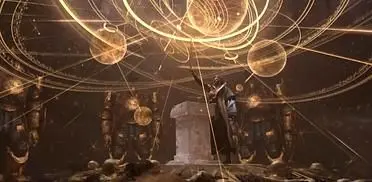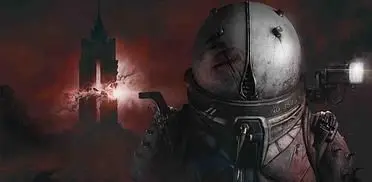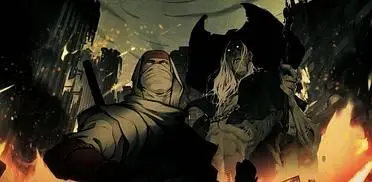Daedalic Entertainment, known for their fantastic adventure games such as The Whispered World and The Night of the Rabbit, have been rather secretive about their upcoming game, Silence: The Whispered World 2.
If you try to find any information about it you’ll struggle to find anything new since it was first announced back in 2013. Fortunately, we’ve managed to get in contact with Ralf Kessler (Producer) and Ulrich Wanitschke (Lead Game Designer) who have given us some more information about their game.
GameWatcher: What changes have been made to the Silence: The Whispered World 2 since you first announced it back in 2013?
Ulrich Wanitschke: It’s rather difficult to tell too much about a game that focuses heavily on story because obviously if we tell too much about the story then we’ll spoil too much. So what you can find online is mainly what we tell everyone, which is what the story is about. It will be about Noah and Renie, they are two siblings that are trapped in this world called Silence. Silence is the world between life and death. You play as both of them as you try to escape this world called Silence, meaning you try to escape death.
For the gameplay itself, we were feeling around a lot and later in production we added console support. As this is our first console game in development we came to the conclusion that as this is an author’s game about story, a much more cinematic kind of game. It’s not so much about the gameplay itself, the gameplay is rather there to support our story and not to stand in its way.
When it comes to changes, we really had to learn a bit about consoles. In the end we could support PC and Mac players but also PS4 and Xbox One players as well with different kinds of controls and input systems, so it’s not a lame port from PC to console but designed for each platform individually. This sort of method forced us to make some changes in the game from 2013 to now, to make some changes for the consoles that feels more natural.
GameWatcher: This will be the first of your adventure games to come to consoles. Are you expecting a different audience to experience your games? If so, have you tried to accommodate for these players?
Ulrich Wanitschke: For consoles, we know we have them all in our living rooms, not in our working stations. The living room is more a leisure time environment that you try to chill out in the evening after work. I don’t want to say we have made the game more casual or something like that, but to make it more playable for the kind of audience who has let’s say two hours in the evening after a hard days work. There are no hardcore puzzles that you have to solve until you can finally go on to the story and you don’t have to spend several of your evenings to solve some stupid puzzle.
You may already know where the game is heading towards as we have designed where we want the player to go, but we’ve put a stupid puzzle in the way just to kill time. That’s not our goal here. We want to tell the story very fluently and going forward every input should give you the feeling that you achieved something or learnt something about this world. We designed it in a way that you can follow the red line of the story so you know, ‘this is where the game wants me to go and I want to follow the line because I want to know what’s going on’. But I can also say, ‘oh, this is the red line but I want to stray off and go explore a little bit’. We’ve hidden a lot of small secrets that you can explore and find. This gives you a feeling that you can learn more about the characters themselves and some sort of how the story goes on without solving some hardcore puzzle.
GameWatcher: Will players need to have played the first game to understand what is going on in Silence: The Whispered World 2?
Ulrich Wanitschke: As we’ve changed our target group there is no chance that we can make this game based heavily on the first part of The Whispered World, so we’ve made some sort of summary where you can learn all the really important facts about the first part so you can play Silence completely independently. If you are a fan of The Whispered World you will still feel at home.
GameWatcher: Was the decision to deviate from the much loved hand-drawn 2D art style a difficult one?
Ulrich Wanitschke: When we announced the game back in 2013 we got a lot of rather negative feedback about how we dared to put it in 3D, how it is stupid and whatever. They had not seen a single frame of our game yet but they were starting to judge whether it was good or bad! Actually, Marco Hüllen, our art director and creator of Silence: The Whispered World 2 felt responsible for this. Marco Hüllen is also responsible for the style of the first game. It was the creator’s own decision to switch from 2D to 3D! If you’ve already seen footage of our 3D environments, we use a projection mapping technique which is a technique that preserves all the 2D aspects of our hand drawn backgrounds and focuses still on that 2D feeling. We expand into the third dimension to have more flexibility to get more angles and more dramatic shots as we know from cinema which is in 3D space. It’s rather easy to achieve in 3D and harder to do in 2D because in 2D every single frame needs to be redrawn if you choose another camera angle, therefore you always have this one main camera angle where you can see the whole game in 2D.
I think we have press release material where we have a video about projection mapping that shows how it all works. The technique preserves all these hand drawn backgrounds, getting all the stuff from the 2D backgrounds while maintaining a 3D space. We worked hard on getting the 3D characters to work perfectly in the 2D environment so they don’t pop out or something like that. It is one piece of art that is timeless because it is not so heavily depending on the latest version of DirectX 11 or whatever. If you play this game in twenty years or however long you will still have this hand drawn background kind of style which doesn’t age because you can’t read the age from a drawing, so much as you can from the next high-polygon-tessellation-shader-mapping-thing from the next benchmark game or whatever.
So to go back to your question, it wasn’t so hard to go to from 2D because of all the positives that we get from moving to 3D. We get to keep the positives from 2D while gaining the benefits from being in 3D.
GameWatcher: Has the transition from 2D to 3D art changed the way you’ve designed the game at all?
Ulrich Wanitschke: Yeah, you get a lot more possibilities because of the 3D space and it gives the designer more freedom to create gameplay to pick something up or to change character. If you have a 3D character, it’s one object for the character, then he puts on a stupid silly hat, this is another object and you can use it, it’s there, it’s done. In 2D, you have these eight directions where a character can walk. Now imagine that character puts on the hat, now we have to redraw the hat for eight directions. So first of all, if you design for a 2D game you have to always keep an eye on the budget. You don’t do something like putting a hat on a character if he has to walk around. It means a lot of frames, a lot of time for a short action. In 3D you can do all of this stuff to tell the story, to create your gameplay. I don’t want to say this is cheap because working in 3D also costs money, but you can do a lot more with it for the same money and time in a 3D space. Later in the game you see some sorts of other actions, I don’t want to spoil it yet but it will really describe what you can do in a 3D space to tell the story while you are playing around. It’s not just cinematic stuff, it’s interactive gameplay in the scenery which just isn’t possible in 2D because it is way too expensive and time consuming.
In short, it gives more freedom and more possibilities in the gameplay.
GameWatcher: So would you say you prefer working in 3D compared to 2D?
Ulrich Wanitschke: Yes. I prefer 3D as it gives me more freedom. There’s a lot of good in 2D games, but you have to know what you can focus on. We made this game, The Night of the Rabbit, it was in 2D and had a fantastic atmosphere because of the small details like the sound and the lighting. The characters would also stand around giving you pieces of text and would comment on what you are doing.
You can do all of this in 2D as well and get a great atmosphere where you feel at home and you don’t really mind that it’s in 2D or 3D. But, as a designer, if I am working on a game I won’t have restrictions in a 3D space.
GameWatcher: Some of the complaints about the original game stemmed from the puzzle design and the voice acting. How have you addressed these issues?
Ulrich Wanitschke: I wasn’t part of the first game, but with Silence I was told that the first thing we need to do is look for better voice actors for the international version because the original ones were not well received. I think we’ve found a really cool voice actor who isn’t, uhh, how we put it… well, he’s a cool guy who sounds natural, he sounds caring, he isn’t annoying. He doesn’t have an annoying, squeaky voice. It’s more a loving, caring brother type of voice. He looks after his sister, Renie, and I think we cast the voice actor really well.
Ralf Kessler: Because of the negative feedback about voice acting in The Whispered World, we have focused on the development on voice acting and voice casting.
Ulrich Wanitschke: When we made The Night of the Rabbit, it was the first time we worked with an international voice recording studio in the UK. As we were doing the voice recording in the UK, we had people who were speaking with their mother tongue, they know exactly what sounds correct or incorrect.
Ralf Kessler: We also received feedback from international authors about this game, about the text and voice acting so I think we are going in a good way with this one.
GameWatcher: Earlier in the interview you mentioned the new target audience may have only two hours each day to play games. One of the more popular ways to release adventure games nowadays seems to involve an episodic format. Have you considered releasing games this way?
Ulrich Wanitschke: That’s always in consideration on whether or not this is an option. For this game, it’s more like a movie than a TV series so it wouldn’t work as well to cut that in smaller pieces, it works better to present it as one cinematic piece.
Ralf Kessler: For the cinematic experience we’ve decided to leave this game in one piece. Leaving it as one whole game will provide a cinematic and emotional experience. It would be too difficult to cut this whole experience into pieces so we decided to keep it as one game.
GameWatcher: What do you feel your game does differently compared to the other adventure games on the market?
Ulrich Wanitschke: That’s a difficult question to talk about other studios and ourselves! The first thing to talk about would be to define adventure games. Some people think about LucasArts games like Monkey Island, others might think ‘oh, the new Tomb Raider game is a cool adventure game’.
I think what we do differently is focus on details. To get every single second right so that you don’t feel like you’re in a game because if you find an error or a mistake, a technical issue in a game, your immersion will break and will take away from the story. This takes a lot of time to concentrate on the details. There could be a mistake in the subtle emotions the characters, or an error in the visuals or the sound design. Something as small as a cursor on the screen can put you out of the game. I don’t know how much time other companies put in their games, I don’t want to say anything about that but I can assure from our side that we really do put in a lot of time to all the details. We focus on the main story but if you happen to stray from this path and go into some sort of place that only one tenth of the players will see, we’ve put in the same amount of time and effort for those players who happen to make a different decision from the one we originally planned.
Daedalic clearly love the adventure game genre. They know exactly what it takes to make a great game and it sounds like Silence: The Whispered World 2 is going to add to their list of excellent adventure games. You can get your hands on the game later this year.










